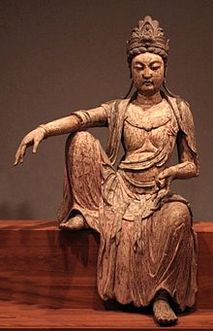
I have a weighty green-hued clay baby-looking Buddha holding a bowl in one hand while the other forms a mudra. This I purchased not long ago in the Civic Center. My marble Ganesha, the elephant-headed god, was a gift from my son and his wife when they set up their altar to Ganesha, who is widely known as the Remover of Obstacles. I have several bent and bearded figures of indeterminate origin who look serious about having given up most of their possessions. But as of yet I do not have a female figure.
Guatama Buddha said, “Love the whole world as a mother loves her only child,” so a female bodhisattva figure would be a good addition to the altar.
I need Quan Yin, an embodiment of compassionate loving kindness. In her bodhisattva vows she promises to hear the cries of all beings and to liberate them from their karmic woes. She is one of the most beloved of deities of the Buddhist tradition with many names in many cultures. And she is a beautiful thousand-armed goddess known for a deep sense of service to all beings. One of the mantras for connecting with her compassionate power is oṃ ma ṇi pa dme hūṃ.
Of course there are other ways of making a practice out of connecting with compassion than adding an icon to an altar. It can be accomplished by looking for what one has in common with people. Of course there are the basics: food and shelter. Most of the people I know also want recognition, affection, and above all, happiness.
Dharma teacher Tara Brach talks about compassion in a blog based on words by the Dalai Lama, “My religion is kindness.” “If we just dedicated our lives to kindness, to the qualities of friendliness and care, we would be directly serving peace on earth.”
She says practicing compassion with others is what we do “as we deepen our longing and our commitment to waking up our hearts.” Interestingly, the first step in engaging with others is to notice with curiosity: “What’s my pattern? Is there an agenda? Are there beliefs that keep me feeling distant and endangered?”
Always Tara reminds us that we need to be gentle with ourselves as we discover what we do that gets in the way of being close to others. What we discover about ourselves will help us be open to others.
I have discovered that in my theater appreciation class at City College, for example, I am impatient with readers who go too slow or stumble over multisyllabic words. I catch myself seething. Without judging my fellow seniors, I am aware of discomfort with what I hear. But no shame, no blame. No one is a professional actor. And it takes courage to do cold readings. As for me, I think I read well. Having taught literature I can do cold readings of Shakespeare because I know about iambic pentameter, etc.
So sometimes I have an attitude and am impatient. It makes sense that years and years of Shakespeare and literature and a smattering of performance classes would cause a level of churlishness. I try to accept my feelings without becoming negative with myself or anyone else. I am aware, too, of other conditions in the classroom that might contribute to my impatience. Poor ventilation doesn’t help.
With any luck my path will continue to bring uncomfortable moments in which to practice becoming a compassionate self who can connect with others without adding a statue to my altar or altering myself by subtracting a trait.
 RSS Feed
RSS Feed